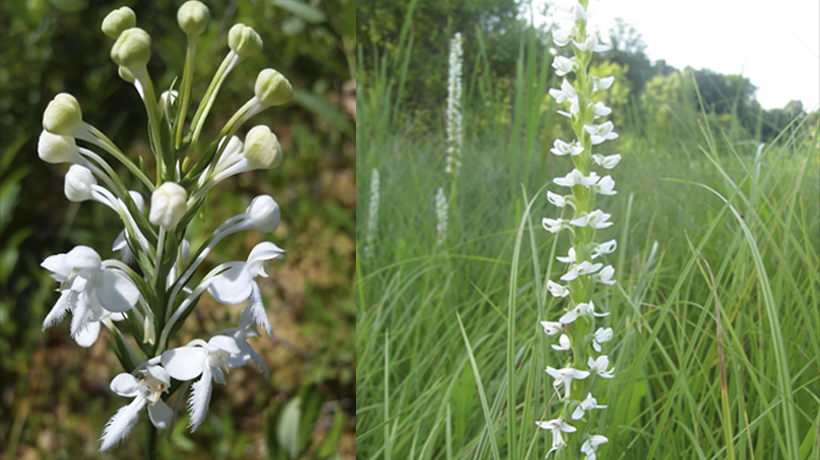- MassWildlife's Natural Heritage & Endangered Species Program
- Division of Fisheries and Wildlife
Media Contact
Marion Larson, MassWildlife

Massachusetts has 16 species of bog orchids (genus Platanthera)—many are in bloom now. Bog orchids, like all of our native orchids, rely on their below-ground fungal associates (mycorrhizae), which interconnect the vegetative community. Without mycorrhizae, the seeds of these plants cannot germinate. If disrupted while growing, they will fail to thrive without their mycorrhizae to provide nutrients. Many of these species will only produce leaves and flowers in years with suitable conditions and survive underground as tubers or corms during the years in-between.
Only some Platanthera actually grow in bogs. Many grow in damp areas with high nutrient levels, including other types of wetlands and rich forests. Of those that do grow in bogs, the most dramatic is the white-fringed bog orchid (Platanthera blephariglottis). This spectacular plant has large flowers with frilly lower petals (in orchids, this is referred to as the labellum) and is a good indicator that the peat bog mat on which it grows has undergone minimal human disturbance. White-fringed bog orchids are pollinated by a variety of bees, moths, and butterflies that have tongues long enough to reach the nectar in the flower’s long spur.
Other types of bog orchids include the large purple-fringed orchid (P. grandiflora) and the small purple-fringed orchid (P. psycodes)—both are tall and showy. Swallowtail butterflies are common pollinators for both plants. The club-spur orchid (P. clavellata), found statewide, is more cryptic and can be difficult to spot. It has a short, dense inflorescence of yellow-green flowers. This orchid can self-pollinate, but a number of pollinators have also been observed visiting the species.
A few bog orchids are listed under the Massachusetts Endangered Species Act. Listed plants include the pale green orchid (P. flava var. herbiola), leafy white orchid (P. dilatata), crested fringed orchid (P. cristata), and orange-fringed orchid (P. ciliaris), which hasn’t been observed since the 1970s and is now considered extirpated from the state.
Several bog orchids are also on the Massachusetts Plant Watch List. MassWildlife's Natural Heritage and Endangered Species Program is monitoring species on this list to learn more about their populations within the state. Watch list bog orchids include:
|
Common name |
Scientific name |
|
White-fringed bog orchid |
Platanthera blephariglottis |
|
North wind bog orchid |
Platanthera. aquilonis |
|
Northern green orchid |
Platanthera. huronensis |
|
Hooker’s orchid |
Platanthera. hookeri |
|
Large round-leaved orchid |
Platanthera. macrophylla |
|
Round-leaved orchid |
Platanthera. orbiculata |
Additional information about these species can be found at Native Plant Trust’s Go Botany.
Despite the difficulties in surveying plants that do not show up every year, MassWildlife is seeing an overall decline in Massachusetts orchids. If you see any of these plants while exploring the state, please submit your observations through the Vernal Pool and Rare Species information system. Your observations help conserve the rarest species of Massachusetts!

